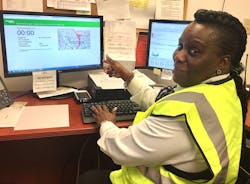From Research to Practice: Implementing Real-Time Control to Avoid Bus Bunching
Have you ever waited for a bus way past its scheduled time to see it finally arrive with one or two other buses tailgating? If so, you have experienced bus bunching. Bus bunching naturally occurs on high-frequency routes. As a vehicle starts running late, it faces growing crowds waiting at stops, and gets further delayed boarding and alighting these passengers. Bus bunching happens when the following buses, which are neither slowed not crowded, catch up to the leading vehicle. Big gaps in service emerge and cause undue waiting time to passengers at stops.
To solve the bunching problem, Dr. Kari Watkins, Dr. Jorge Laval and I have developed a new method to dispatch vehicles. Since it has been shown that passengers tend to arrive randomly at stops when buses come every 12 minutes or less, the method disregards the schedule entirely. Instead, real-time predicted arrivals are used to dispatch vehicles at the same frequency as they arrive. When a vehicle is predicted to arrive with great delay, each preceding vehicle is held to absorb its fare share of that delay. The method is the first to explicitly consider every vehicle on the route to produce a natural headway, which may fluctuate throughout the day, based on current operating conditions.
In a series of simulation experiments, we have compared the method with others used in practice and recommended in the literature in a wide range of operating conditions. We found that the method could dispatch vehicles with the most stable headways and the least holding time on a wide range of operating conditions. Although encouraging, these results were limited to the conceptual interpretation of a high-frequency route. In order to determine the applicability of the method and test its performance, we needed to implement it on a live transit route.
To hinge the research toward practical implementation, we partnered with Sean Óg Crudden, an independent software developer from Ireland. Based on an open-source prediction platform called TransiTime, we built a series of tools that compute recommended holding times. Sean Crudden created the first open-source frequency-based prediction algorithm in the process. The end result was a dashboard that displayed a countdown to the recommended departure time, a map of the system with real-time vehicle positions, along with other arrival and departure information.
In the spring of 2017, we successfully implemented the proposed holding method on three high-frequency transit routes, the Atlanta Streetcar, the Georgia Tech Red Stinger Route and VIA’s Route 100 in San Antonio, Texas. In all three case studies, the method replaced the schedule for several hours at a time on one or multiple days. In each case studies, dispatchers instructed operators how long to hold at control points using the DynamicTime dashboard.
In all three transit routes, the method reduced bus bunching and big gaps in service, compared to the regular schedule. On the Atlanta Streetcar, 43 percent of headways were within a two-minute interval under the proposed method against 31 percent under the schedule. On the Georgia Tech Red Route, the proposed method was able to recover from severe bus bunching that was triggered before the start of the implementation. On the VIA Route, the method systematically maintained the most stable headways when compared to the schedule in similar periods of historical data.
Through the implementation of the proposed method, we tested the importance of vehicle-location data quality and prediction accuracy. The DynamicTime software was able to manage the issues of wandering signal and low polling frequency of the vehicle location feed we encountered. Losing GPS signal for several minutes at a time, on the other hand caused substantial problems, but this issue only occurred on one of the three routes. Finally, we found the frequency-based prediction algorithm to be adequate for this application.
Involving dispatchers in the communication protocol improved operator accountability but also created opportunity for confusion. Knowing they were monitored, operators had a good reason to follow instructions with more diligence than usual. However, in certain situations, such as a traffic collision, construction or other discrete events, operators needed to make ground-level decisions. We found that operators are the best positioned to make the final judgment call, and should therefore be provided holding instructions directly.
The implementation of the proposed method on three high-frequency transit routes has showed that prediction-based holding methods can be used to avoid the bus-bunching problem. The next step should be to implement the method with tablets inside vehicles or kiosks at control points to communicate holding instructions directly to operators. All the tools developed in this research are available in open-source format for any agency to implement and expand.
Dr. Simon Berrebi, Dr. Kari Watkins and Dr. Jorge Laval research ways to optimize public transportation with real-time information at Georgia Institute of Technology.
